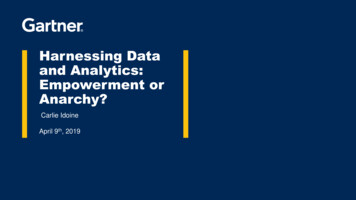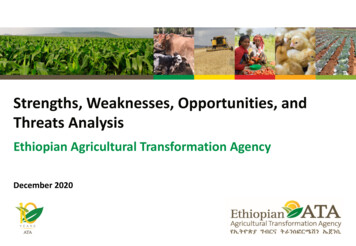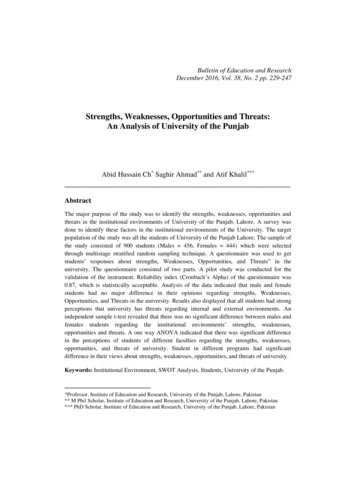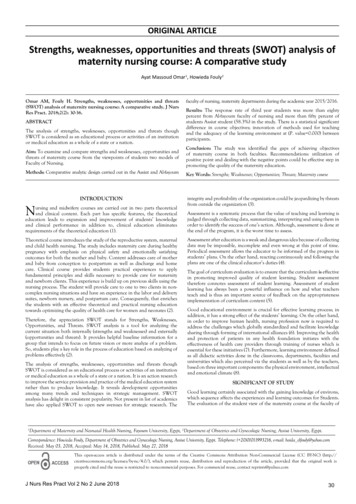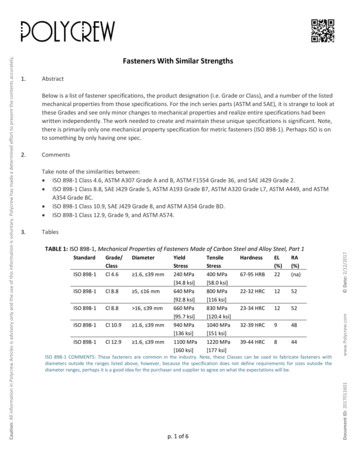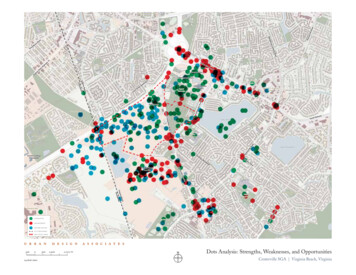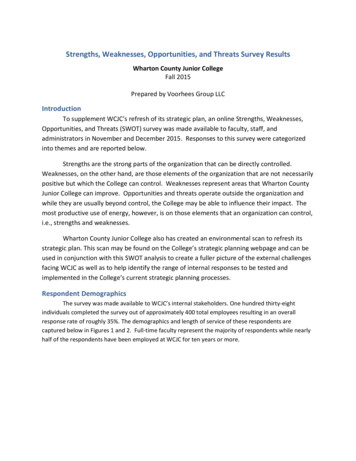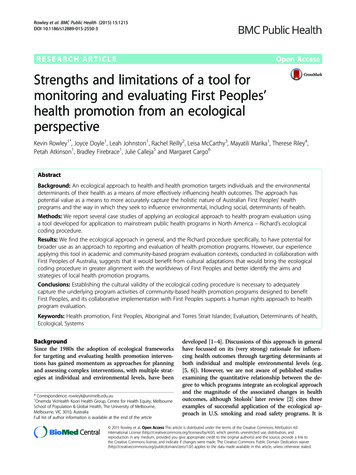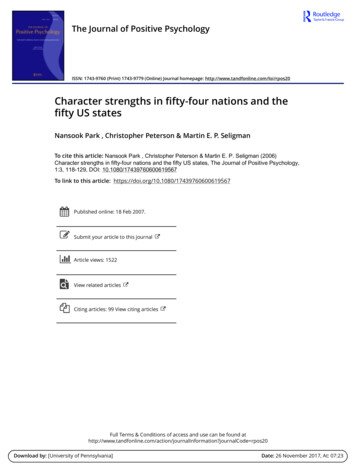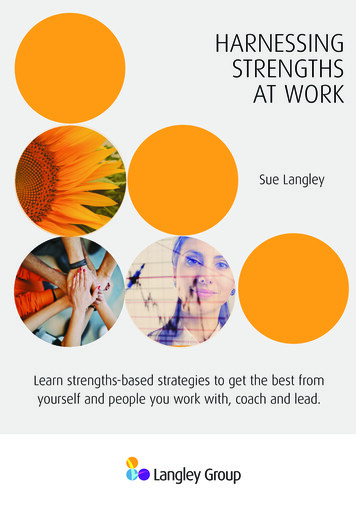
Transcription
HARNESSINGSTRENGTHSAT WORKSue LangleyLearn strengths-based strategies to get the best fromyourself and people you work with, coach and lead.
Everyone has strengths and the potential todevelop them to be the best they can be.IntroductionResearch shows that knowing and growing our strengthshelps us feel energised and engaged. We learn faster,perform better and strive to do our best every day.When those strengths are harnessed andcombined with others’ great results inevitablyfollow. It’s a win for the individuals whosestrengths are realised and leveraged—and awin for their organisation, managers andteams.This eBook introduces you to someof the most practical and researchbacked ways to realise your strengthsto achieve better performance,satisfaction and fulfillment at work.It also shares strengths-basedstrategies to bring out the best inpeople you work with, coach and lead.You will learn: Why strengths matter and some ofthe latest research A practical framework for realisingstrengths at work Strengths strategies in leadership, coaching,performance, talent management andteamwork.We look forward to inspiring you and others to realiseand harness their strengths!Sue Langley 2018 Langley Group IP Trust. All rights reserved
“Simply put, strengthsenergise us, enabling usto be at our best.”Alex Linley2
“Strengths are so integral toour identity as individuals andas human beings. They are atthe heart of what it takes tolead flourishing lives.”Alex Linley
WHY STRENGTHS?A strengths approach represents a paradigm shift for manyworkplaces and people. Instead of focusing on problems or whatis wrong—a deficit model—focusing on strengths builds on whatworks well and can work even better.Our strengths are natural and authenticresources that represent what is good ineach of us. They shape our character andour identity, influenced by nature, nurture,life experience and the urge to fulfil ourpotential; a fundamental part of who weare and grow to be as people.We feel intrinsically motivated to act onour strengths and get a buzz that addsto our confidence and competence. Welearn, persist and become more fulfilledover time.Alex Linley defines a strength as:“a pre-existing capacity for a particularway of behaving, thinking or feelingthat is authentic and energising to theuser, and enables optimal functioning,development and performance.” 2018 Langley Group IP Trust. All rights reservedIn other words, our strengths allow us tobe, and to become, our best self.Strengths are at the heart of positivepsychology, and have been a rich sourceof study for the last decade or so.While a clear language of strengths maybe lacking in modern times, many of usknow to “play to our strengths”. Conceptsof strengths, character and virtue haveinfused human history across manycultures. Aristotle extolled us to strive to“live in accordance with the best thing inus” if we want to attain a good life.Recent scholars are exploring thescientific underpinnings for why strengthsmatter and the benefits that strengthsbring. Strengths are now an integral partof the formula for human flourishing andworkplace performance.4
Strengths are at the heart of engagement—thatelusive workplace concept that enhances employeecontribution, leading to increased productivity, higherprofits, greater commitment and retention.Research shows that when people use their strengths they performbetter, achieve results faster and feel more satisfied, energised andengaged. They are motivated and able to go above and beyondbecause they are doing what they love and do best.It should be no surprise then that the most engaged employees arethe ones who use their strengths at work most of the time.In fact, a global study by the Corporate Leadership Council of almost20,000 people across multiple organisations, industries and countriesfound that when people were encouraged by their managers tofocus on their strengths, their performance rose a massive 36%.When they focused on their weaknesses, performance dropped by27%.By putting aside strengths to slog away trying to improve the thingsthey weren’t naturally good at, they likely worked a lot harder fordiminishing results, feeling increasingly dispirited and disengaged.They may also have felt their manager didn’t recognise andappreciate them for who they are as a person and the strengths theyyearn to contribute in their role.A strengths approach attunes us to the positive without denyingrealiity or the negative. It does not mean ignoring weaknesses—afterall, we all have them and they can pose a real risk. What it doesmean is being aware of what we don’t do so well and creatingrealistic strategies to minimise them and their impact.It can depend on our role. Not all weaknesses need to be improved.As we will see, there are many strategies we can choose to morefully harness our strengths. 2018 Langley Group IP Trust. All rights reserved
“A person can performonly from strength. One cannotbuild performance on weakness,let alone on something onecannot do at all.”Peter DruckerChange in Performance40.0Change in Performance40.020.036.436.420.0Focus onWeaknessFocus onWeaknessFocus onStrengths-20.0-20.0Focus onStrengths-26.8-26.8-40.0Corporate Leadership Council study of 19,187 people-40.0 Langley Group 2015Corporate Leadership Council study of 19,187 people Langley Group 2015 2018 Langley Group62
BenefitsFor people who use their strengths more.OrganisationsIndividuals 2018 Langley Group IP Trust. All rights reserved
Studies link strengths with individualand organisational thriving.For example, Reena Govindji and Alex Linleyshowed that people who use their strengthsmore have higher levels of subjectivewellbeing (happiness), psychological wellbeing(fulfillment), self-efficacy (confidence) andvitality (energy). Others have reported lowerlevels of stress over time.Another study found that those who use theirstrengths in striving to acheive goals were farmore likely to reach them. When they did theysatisfied psychological needs and were happierand more fulfilled as a result.Ken Sheldon and his colleagues found thatwhen focussing on self-development, peopleimprove faster on areas where they arealready strong than those where they areweak. Leaders who focussed on developingthemselves and their teams through strengthshave also been shown to be more effective andsuccessful. Capp 2015In organisations, the opportunity to doyour best everyday is a core predictor ofworkplace engagement, which in turn predictsproductivity, profits, commitment and otherbusiness outcomes according to Gallupresearchers. Data from Alex Linley’s work withNorwich Union showed that people workingfrom their strengths perform better and staywith the company longer.Studies highlighted by Capp in Why Strengths? The Evidence (2010) andR2 Strengths Profiler Accreditation (2015). See references for more.8
“Each of us has much more hiddeninside us than we have had achance to explore.”Muhammad Yunnus
REALISING YOUR STRENGTHSDo you know your strengths and those of the people around you?Until we really understand them, we can miss the power andbenefits of a strengths approach.Realising your strengths means knowingand growing them. It also means beingmindful of when, how and how muchto use your strengths to achieve optimalperformance, development and potential.Many coaches stop at helping peopleidentify their strengths or simply urgethem to use their strengths more often.This doesn’t always produce optimalresults or help you improve.Some people have criticised the strengthsapproach for this reason. There aremany examples of executives whohave overplayed their strengths tothe detriment of themselves and theirteams. Robert Biswas-Diener, an expertin strengths coaching, advises a morenuanced approach.There is a Golden Mean for using yourstrengths. So that you do not underplayor overplay them, use the right strength,in the right amount, in the right way at 2018 Langley Group IP Trust. All rights reservedthe right time. Consider this an optimalperformance ratio—for best effect, dialup or dial down the strength to meet thedemands of the situation.Strengths are far less static than manypeople think. They evolve, changing withyour context and role. Understandingthis helps you adopt a Growth Mindsetrather than a Fixed Mindset, a conceptpioneered by Carol Dweck. She foundthat if people believe their basic qualitieslike intelligence or talent are statictraits they don’t spend time developingand nurturing them. Our strengths, likeourselves, are a work in progress!You can get to know your strengthsinformally or by taking a formal strengthsassessment. On the next pages youwill find tools to start identifying, usingand developing strengths based on theStrengths Profile. There are others such asthe VIA Inventory, Gallup Strengths Finderand StrengthScope.10
StrengthspottingYou can learn to spot strengths in yourself and others daily.Signs of strengths can be observed in any conversation if youwatch and listen. When you notice over time, patterns emerge.You can use them in any situation, from conversations with team members to newbusiness prospects; candidates for a role to people you meet at a networking event;or simply for your own self-reflection.Here are ten strengthspotting tips.1Childhood memories2Energy3Authenticity4EaseWhat do you remember doing as a child that you still do now – but mostlikely much better? Strengths often have deep roots from our early lives.What activities give you an energetic buzz when you are doing them?These activities are very likely calling on your strengths.When do you feel most like the “real you”? The chances are that you’llbe using your strengths in some way.See what activities come naturally to you, and at which you excel –sometimes, it seems, without even trying. These will likely be strengths. 2018 Langley Group IP Trust. All rights reserved
5AttentionSee where you naturally pay attention. You’re more likely to focus onthings that are playing to your strengths.6Rapid learning7Motivation8Voice9Words and phrases10What are the things that you have picked up quickly, learning themalmost effortlessly? Rapid learning often indicates an underlying strength.What motivates you? When you find activities that you do simply for thelove of doing them, they are likely to be working from your strengths.Monitor your tone of voice. When you notice a shift in passion, energyand engagement, you’re probably talking about a strength.Listen to the words you use. When you’re saying “I love to.” or “It’s justgreat when.,” chances are that it’s a strength to which you’re referring.To do listsNotice the things that never make it on to your ‘to do’ list. These thingsthat always seem to get done often reveal an underlying strength thatmeans we never need to be asked twice.Strengthspotting tips from Average to A :Realising Strengths in Yourself and Others,by Alex Linley.128
StrengthsProfileThe Strengths Profile approach represents animportant development in positive psychology,strengths assessment and development.As we have seen, a key ingredient in strengths is the energywe feel when we use them and the positive emotions thatgenerates. Distinguishing between things we do well thatenergise us and those that de-energise us has been themissing component in strengths approaches and tools.Also lacking is the importance of context and thedynamic and evolving nature of our strengths. Withoutthese insights, many have failed to gain the benefitwe expect from using our strengths.Strengths Profile (formerly R2 Strengths Profiler) is designedby Alex Linley and his team at Capp to identify and developstrengths in individuals and teams, synthesising the latestresearch. Whether you are familiar with the tool or not, orperhaps use other frameworks, you can apply the SP lens quitesimply when working with your own or other people’s strengths.By adding the dimension of energy and context, you can build aricher understanding of where strengths are being used and howbest they can be capitalised. For each strength consider: Performance – How well do you do it? Energy – How good do you feel when doing it? How muchenergy do you gain? Use – How often do you do it? In which situations? 2018 Langley Group IP Trust. All rights reserved
STRENGTHS DEVELOPMENT MODELUse realised strengths wiselyThese are things you are good at, enjoydoing and do often. They are generally yourmost recognised and available resourcesfor sustained performance, wellbeing andengagement. Marshal realised strengths byusing them appropriately for your situationand context.Use unrealised strengths moreThese are things you are good at, enjoydoing and do less often. These strengthscan be areas of untapped potential,waiting for the right situation or time tosurface and develop. Find opportunities touse them more.Use learned behaviour whenneededThese are things you are good at yet finddraining. They can reveal areas of potentialburnout in your current role or the overuse ofcertain strengths. Use them in moderationand only when you need to.Use weaknesses lessThese are things you are poor at andalso find draining. They are areas whereperformance and motivation are lowest,yet are often targeted for development.The goal here is to minimise their impactand use them only where necessary.14
“Realising our strengths is thesmallest thing we can do to makethe most difference.”Alex Linley
STRENGTHS STRATEGIESWe can learn to use our strengths in new and better ways tobecome even stronger. Here are a few strategies to stretch,challenge and team up with people to play to your strengths.Strengths constellationsSome more tips:Our individual constellation of strengthscome alive in different contexts. Bycombining our most energising strengthswe can maximise their effect and createan upward spiral of positivity and growth.Better still, find ways to play a symphonyof strengths with other people. Reflect on the strengths that haveproved most successful before. Howdid you combine them? In whatsituations did they work best? Focus on strengths you want to beknown for in your work, future careerand personal brand.Strengths partnerships Find people who can be role modelsfor emerging strengths. Be honest. Tell people yourweaknesses and allow them tooffer their strengths in return. Whatweaknesses do you really needtraining and development to address? Organise tasks to sandwich activitiesthat drain you between those thatenergise you. Consider sustainability. Are youtaking some strengths too far? Whatstrengths may be better to startdeveloping now?Find complementary strengths partners– someone at work or home who cancompensate for your weaknesses or takeover when you get drained.Calibrating strengthsConsider the results you want and selectwhich strengths are best to achieve them.Remember to be mindful of how yourstrengths affect others. Go deeper byobserving and reflecting on what is goingwell. Refine your actions with feedback. 2018 Langley Group IP Trust. All rights reserved16
“The unique purpose oforganisations is to make strengthsproductive. To achieve results,one has to use all the availablestrengths.these strengths are thetrue opportunities.”Peter Drucker
STRENGTHS BASED ORGANISATIONSIf performance and engagement are top priorities in organisations,how much more potential can be realised when each individual isplaying to their strengths?While a strength approach is gainingmomentum, not everyone is clear whattheir strengths are and how to capitaliseon them. Critically for organisations,neither are their managers or humancapital leaders.Realising strengths and the energy thatfuels them is a natural route to enhancingemployee contribution, engagementand performance. Knowing individualstrengths and how to harness themenables you to get the best from peoplethroughout the employee life-cycle andat every level of the business.When applied effectively and holistically,a strength-based approach can be thekey to an engaged, high performingworkforce. Perhaps most importantly,it reaches beyond traditional talentmanagement to find hidden value andtalent that can re-engage and invigorateindividuals and the organisation. 2018 Langley Group IP Trust. All rights reservedThere are many ways to integratestrengths into how your organisation doesbusiness. Here is a five step guide:1. Identify strengths with a blendof formal assessment tools suchas Strengths Profile and informalapproaches like strengthspotting,strengths cards, strengthsconversations and strengths sessions.2. Apply strengths strategies andempower people to autonomouslychoose and use their strengths.3. Develop strengths through trainingand coaching from graduate toexecutive level.4. Appreciate strengths with strengthbased feedback, performanceconversations and recognition.5. Reinforce strengths throughout HRsystems and processes. Make thempart of your employee and customervalue proposition.18
BusinessapplicationsHow can organisations start harnessing strengths?Drawing together what we’ve learned so far, here are ten tips for business.1Tap into unused talent throughout the organisation2Attract and retain more of the people it needs3Improve individual performance4Build employee engagementTo the extent that the strengths of employees are not being harnessed,there is untapped talent and energy in the organisation. Much time andresource is spent in attempting to improve performance, but little of thatis directed at getting the best out of people.People like to use their strengths: doing so reinforces and re-energisesthem. A strengths based organisation will be more attractive in theemployment market, especially to Generation Y. Without the opportunityto use their abilities, many people leave.Individual performance is significantly improved by a focus on strengths,and undermined by a focus on rectifying weaknesses. The traditionalapproach of molding individuals to jobs and focusing development efforton correcting weaknesses have proved unsuccessful.Use of strengths is one of the key drivers of employee engagement,which itself is linked to improved employee retention, discretionaryeffort, quality, customer satisfaction and loyalty, sales, profitability,shareholder return and business growth 2018 Langley Group IP Trust. All rights reserved
5Develop flexibilitySelected and deployed on the basis of strengths – less on the basis ofwhat they ‘have done’, and more on the basis of what they ‘could do’ ina variety of future roles – employees are more willing and able to acceptchanges in role and organisation.6Improve teamwork7Increase diversity and positive inclusion8Increase openness to change and ability to deal with change9Deal more positively with restructure10A focus on strengths in teams allows for the efficient allocation of tasksand, with greater role flexibility, encourages cooperation. The positiveemotions generated by the use of strengths enable social integration.An understanding of strengths encourages people to value difference.The person who once appeared aloof is now understood to play a vitalrole and may absolve me from my non-preferred tasks. Teams made upof people who differ tend to be more creative and perform better.The use of strengths generates positive emotions which facilitateperformance by broadening people’s mind sets, encouraging them todiscover new ways of thinking and acting, building resilience and theability to deal with the after-effects of negative events.When faced with a restructure, using a strengths-based approach meansyou can offer a process that meets best practice requirements whilstappointing top performing individuals into key roles that are mappedagainst the future business requirements.Contribute to the happiness and fulfilment of employeesApart from being more likely to achieve their goals, people who usetheir strengths experience higher levels of energy, wellbeing andauthenticity. This combination of organisational and individual benefitshelps create a high performance workplace in which you have engagedemployees.Business tips by Capp available in the R2 Team Facilitator Manual (2015)and Strengths Profile Accreditation Workbook (2015).20
When leaders know their own strengths andthe strengths of their team, they can create apositive culture where strengths are harnessedand people excel.Take a strengths assessment to discover your strengths. Thinkabout the strengths that have enabled your success so far. Arethese the ones you want to be known for now? Do you need todevelop different strengths to get to the next level as a leader?Be honest about your career goals and the roles that will allowyou to deliver your best.Work with a coach, mentor or boss to create a developmentplan that leverages your strengths and authentic leadershipstyle and builds on your potential. Focus on activities you canapply daily to feel more energised, motivated and engaged.Build positive relationships within your team by emphasisingpeople’s strengths. When you recognise what someonedoes exceptionally well, they will feel more motivated andcommitted to keep doing their best. Spot strengths andchallenge people to develop. When they consistently volunteerfor certain activities, chances are they will play to strengths.Consider ways to make meetings more collaborative, productiveand energising by tapping into strengths. Encourage peopleto use their strengths to offer unique insights and solutions toachieving strategic goals.HintCelebrate wins byencouraging people to sharestories about strengths andhow theses contributedto success. 2018 Langley Group IP Trust. All rights reserved
Leadership222
Performancemanagement
HintAlign KPIs and developmentplans to strengths. Setperformance goalsthat challenge andstretch strengths.People place a high value on relationships withtheir bosses. They want them to understandtheir strengths and manage them according toindividual needs.A strengths-based approach to performance management,whether in formal reviews, feedback conversations or dayto day, is individualised and motivating for managers andthe people they lead. It helps build positive productiverelationships and retain talented people.Too often performance management is seen simply as dealingwith disciplinary issues or poor performers. Many managersdon’t like and avoid performance conversations. They can lackthe skills, positive frameworks and motivation to do it well.Strengths-based performance conversations are active, positiveand more likely to elicit top performance; and they’re easierto hold. People are far more able to realistically discuss howto minimise the impact of their weaknesses when they knowtheir strengths are being recognised, rewarded and developed.Teach managers how to spot and leverage their team’sstrengths and hold performance conversations that focus onstrengths. Look deeper to see how these are playing out. Is itlip service or are people really bringing strengths to life?For maximum impact, integrate a strengths lens intoperformance management processes and metrics. 2018 Langley Group IP Trust. All rights reserved24
It’s tempting to focus on bridging gaps andimproving weaknesses when we want to guidepeople to succeed. Yet we do so at the expenseof making full use of their strengths.If you are a coach, manager or people development leader,focusing on strengths is one of the greatest differences you canmake to get the best from people. Help maximise strengths andminimise weaknesses by considering some of these questions: Which strengths energise them most? How can they applythem to stay satisfied, engaged and performing at theirbest every day? Can they partner with team members who possesscomplementary strengths? Can they spend more time on projects and tasks that playto their strengths? Where weaknesses impact, which strengths can they drawon instead to achieve the same goals and really excel? Which strengths, if developed, hint at untapped potentialthat may propel them in the next stage of their career?For those who tend to overplay certain strengths, how canthey be more mindful about how they use these strengths?For example, a leader who habitually overplays Drive andCompetition may need to dial up Compassion to sustain histeam’s engagement when they show signs of burnout.HintA ‘development opportunity’can be an opportunity todevelop strengths ratherthan weaknesses. 2018 Langley Group IP Trust. All rights reserved
Coachingand careerconversations262
Delegation andteamwork
HintConsider what strengths arerequired to complete a task.Does anyone have thosestrengths? If yes,delegate it!When people know their own strengths and thestrengths of others in their team, they are betterequipped to leverage them together.Strengths-based delegation and teamwork is a core toolmanagers can use to transfer organisational strategy into teamgoals and individual objectives. When people’s strengths arealigned to the organisation’s mission and their team goals,collaboration and performance skyrocket.Team members can work in complementary partnerships tomaximise each other’s strengths, compensate for individualweaknesses or offset de-energising behaviours.When tasks and roles are aligned with their strengths, peopleare more likely to work faster and experience a sense of ‘flow’in their work. This leads to higher quality work. Goals becomemore satisfying, meaningful and attainable because people aredoing what they intrinsically love and do best.A language of strengths also helps team members understandthemselves and each other. It gears conversations towardmutual respect and appreciation by highlighting what eachperson can contribute. A tool such as the Strengths TeamProfile shows the diverse strengths available across a teamand provides a positive framework to unite people in movingtoward their goals. 2018 Langley Group IP Trust. All rights reserved28
Research now shows that recruiting for strengthsrather than competencies is more effectivein hiring talent that is engaged, productive,effective and able to grow in their role.When Aviva recruited customer advisors for their strengths,the company experienced 39% reduction in cost per hire, 54%reduced call answer delays and 50% less turnover in the firstyear. Onboarding new talent selected for strengths has alsoshown to be 50% faster than the competency-based model.If you are looking to find and retain the right talent, targetstrengths. Start by defining the strengths likely to be useful forthe role and organisational context. Consider which strengthsmight help or hinder high performance. Which may be neededto complement those already present in the organisationor team. Use those insights to attract the right people andintegrate them into job descriptions, marketing and branding.Use a strengths-based assessment tool as part of therecruitment and selection process. Keep an open mind ratherthan following a formula. People use their strengths in creativeand often unexpected ways so try not to pidgeon-hole them.For example, relationship strengths like Rapport Builder may beimportant in a sales role and if these appear to be de-energisingyou may have some concerns. On the other hand, a strengthlike Mission may ultimately be more important than Preventionin a health and safety role.HintHold strength-basedinterviews informed byassessment andstrengthspotting. 2018 Langley Group IP Trust. All rights reserved
Recruitmentand selection302
350,000 people havecompleted Strengths Profileacross 25 countries. It isconsidered the most robust andvalidated strengths tool today.
ResourcesASSESSMENT TOOLSStrengths ProfileStrengths Profile is designed to unlock performance, energy and potential byrealising people’s strengths. Unique from traditional one-dimensional strengthstests, it assesses 60 strengths across three dimensions of energy, performanceand use, revealing a dynamic set of realised strengths, weaknesses, learned (orde-energising) behaviours and unrealised strengths. Team Profiles and ManagerInsights are also available.We recommend a debrief with one of our qualified experts to help you designpersonalised strategies and get the most from your strengths.Available at Langley Group.» Order now » EnquiriesStrengths CardsExplore strengths with 60 cards drawn from Strengths Profile. Play strengths gamesto discover your strengths and those of others. Use them as quick reference toolsto help develop your strengths day to day or harness them toward your goals. Idealto facilitate strengths-based conversations and introduce people to their strengthswithout indepth assessment. Strengths Book available.Available at Langley Group.» Buy now 2018 Langley Group IP Trust. All rights reserved32
COURSES & CONSULTINGStrengths Profile AccreditationStrengths trainingWould you like to learn more aboutharnessing people’s strengths?Professional certification in StrengthsProfile is ideal for coaches, facilitators,managers, team leaders, HR practitioners,and consultants who want to unlock anddevelop strengths.Ask us to design and deliver strengthsbased training in your organisation orprofessional network. From short sessionsto indepth leadership training, peoplefind discovering and working from theirstrengths motivating and engaging.Open courses and inhouse training.» Learn moreStrengths Profile Team TrainingTake team performance to the next levelby harnessing strengths. The StrengthsProfile Team Profile reveals strengths thatexist across a team, for better teamwork,engagement, productivity and alignment.Learn how to unlock strengths potentialand design strengths training acrossorganisations.Open courses and inhouse training.» Learn more» Learn moreKeynotes and masterclassesWould you like us to deliver a high impactpresentation about strengths? A freshapproach for human capital managers,business leaders, coaches, consultantsand people development experts.» Learn moreAssessment and talent
It also shares strengths-based strategies to bring out the best in people you work with, coach and lead. You will learn: Why strengths matter and some of the latest research A practical framework for realising strengths at work Strengths strategies in leadership
